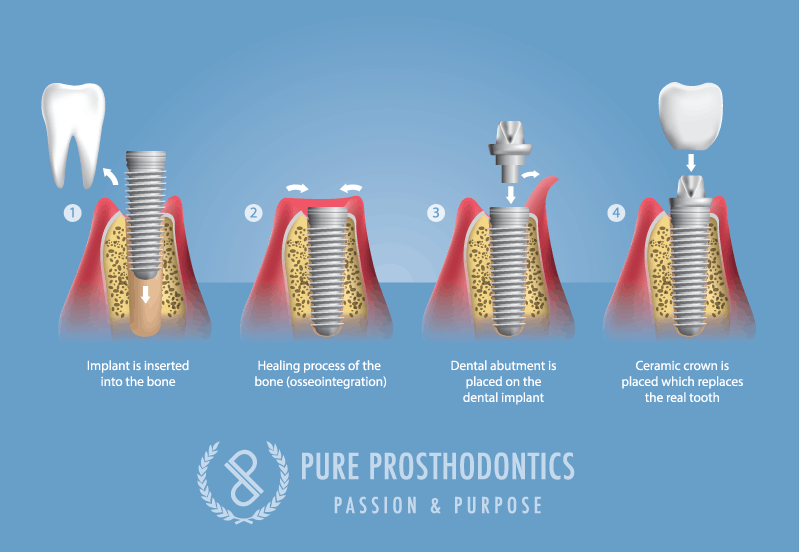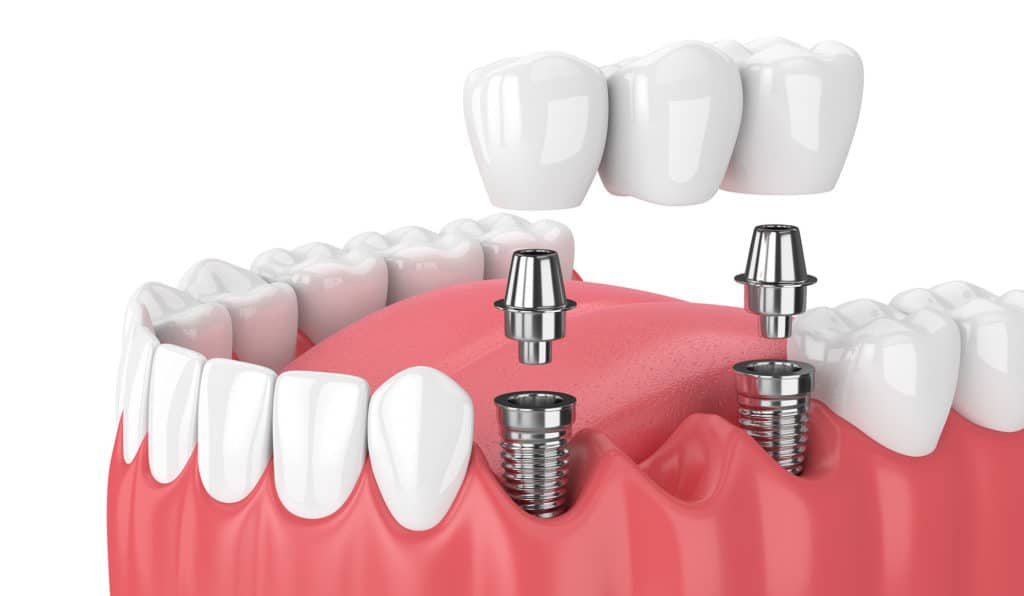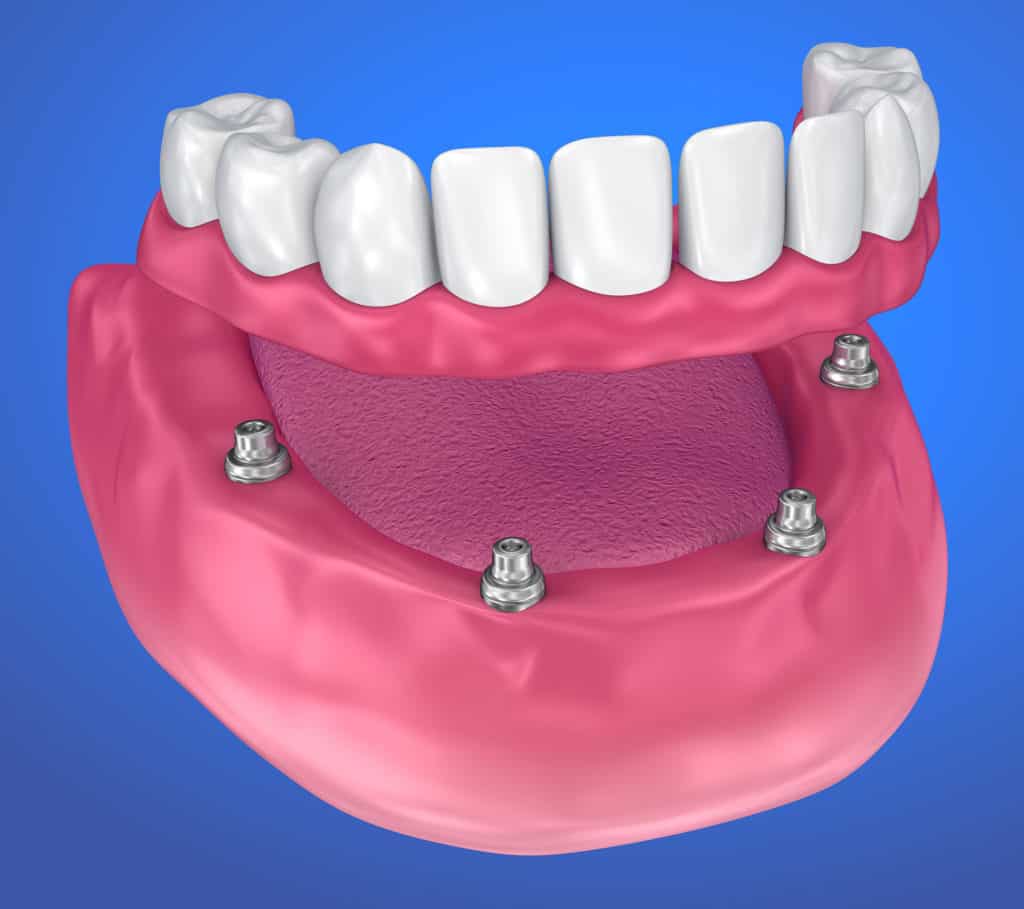Dental Implants 101: Are You Ready to Fully Smile Again?
From natural aging processes to injury or disease, there are innumerable circumstances that may leave your smile only half full. These missing teeth can affect your speech and eating abilities, impact your self-confidence, and often interfere with personal and professional relationships and goals. It’s a plight you don’t have to spend the rest of your life fighting and hiding from, though. At Pure Prosthodontics, our customized dental implant options can restore your full smile so that you can live your life to the fullest.
A common misconception about tooth loss is that the only treatment options are bridges or dentures. This isn’t necessarily true. Individual tooth implants can be a viable treatment option when you’re only missing a tooth or a couple of teeth that are spread out throughout the mouth, and an all-on-4 implant (hybrid prosthesis) can treat those with significant to complete tooth loss that’s widespread through the mouth.
So, what is an individual dental implant? This is an artificial tooth root with a screw akin to what a carpentry screw looks like. It’s inserted into your jaw and gums. An abutment is used to hold the crown in place. The new replacement tooth crown is then permanently attached to the implant. The result looks, feels, and operates just like a natural tooth.
Dental implants typically have three parts:
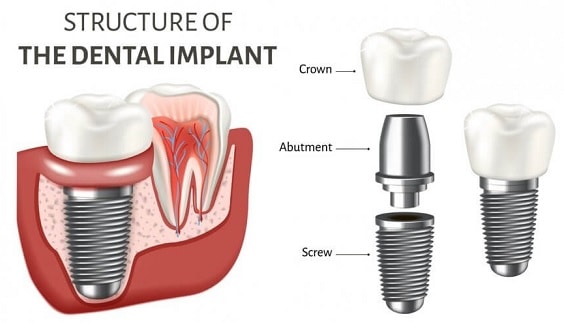
1) The implant: A screw that serves as a root for your new teeth. This is what permanently attaches to your jaw.
2) The abutment: A permanent, but removable by your doctor, connector that supports and holds a tooth or set of teeth.
3) The crown (or prosthetic tooth): This is the part of the tooth that you can see. It’s usually made of metal/ceramic or porcelain for durability and good looks.
Who is a Candidate for Dental Implants?
Thanks to the innovation of modern dentistry, today’s implant dentistry is designed to unassumingly help you gain the smile you’ve always wanted.
Individual implants are restorative in nature, meaning they’re designed to permanently supplement your existing smile verses fully to mostly replacing it. It’s no wonder that it’s so appealing to those who’ve had the misfortune of losing a tooth, right? However, not everyone will be a candidate for dental implants.
Those without enough bone density strength under the gums to adequately support the implant require bone grafting before implant placement. A lack thereof will almost certainly make the procedure a moot point because the implant will quite often not fuse correctly.
Here are some other boxes you should check to help you get an idea if you’re a good candidate for teeth implants:
- You’re only missing one tooth, you have several teeth missing that’s spread out throughout the mouth, or you have the above in an unhealthy tooth that needs to be extracted and replaced.
- Your gums and unaffected teeth are otherwise healthy.
- Your oral hygiene habits are excellent.
- You can commit to a dental process with various phases taking place over a four to six-month span and post-operative healing time of up to three months.
- You’re a non-tobacco user or can stop using during the entire tooth implant process.
- No autoimmune disorders or untreated diabetes.
- No past or current medical treatments that’ve used bisphosphonate, such as certain cancer treatments or medicines for osteoporosis.
What Are the Benefits of a Dental Implant?
If you are a candidate for dental implant tooth replacement, you will be happy to know there are quite a few advantages over the bridge and denture options, including:
- Strength – dental implants are stronger than bridges and dentures, which ultimately makes them a more permanent solution for tooth loss.
- Aesthetics – they look more natural than other tooth loss treatment options.
- Convenience- care is the same as natural teeth, and you can elect to replace a single tooth at a time or all your missing teeth.
- Comfort – dentures and bridges are both more apt to loosening. Dental implants are typically more comfortable and easier to adjust for talking and eating.
- Jaw integrity – helps align your bite and maintain your jaw’s integrity, which then reduces bone loss.
What is the Dental Implant Process?
Dental implants are a multi-visit treatment, but you will find that is a very streamlined process.
Your first step is always a dental consultation with our office to ensure you are a good candidate for dental implants. Dr. Yepez is likely to order some initial labs and x-rays and may even make a model of your teeth and mouth. Based on the exam results, he will be able to determine if both your overall health, oral condition, and bone density test are all a fit for dental implants. If so, you can expect the dental implant process and timeline to look like this:
- Dr. Yepez will develop a treatment plan, which will include special considerations like preexisting medical conditions that could affect healing and a timeline for dental implant placement.
- If the damaged tooth is still in place, then your dentist will extract it and its roots. Dr. Yepez will determine if the dental implant can be placed within the removed tooth’s socket or if a bone graft will be needed for placement.
- After you’re healed from the prep work, which may take up to three months if you had a bone graft, it’s time to return to the dentist so he/she can place the titanium implant in your jaw. It can take a few months to a few weeks (depending on your health) to heal enough to move on to the next step.
- Once your dentist declares your implant has healed sufficiently, the abutment is placed on the implant. If they haven’t already been made, your dentist will make molds of your mouth so he/she can order the right fit for the crown. Note that the abutment and final mold step can occur when the implant is placed, but that decision is up to the dentist and usually based on the condition of the jaw.
- Your crowns are ready, and it’s time for your dentist to attach them to the abutment. He/she may have to adjust it a bit to ensure a comfortable and proper fit.
What to Expect Post-Dental Implant
Dental implantation is still an oral surgery, and, as such, you can expect some mild discomfort. You may also experience the following over the first few days after each invasive step of the procedure:
- Difficulty swallowing and chewing.
- Gum, jaw, and facial swelling and discoloration.
- Mild to moderate pain.
- Mild bleeding.
Dr. Yepez will provide postoperative care instructions for you to follow, which may include:
- A prescription for antibiotics.
- NSAIDs for pain and inflammation relief.
- A soft diet.
- Warm compresses.
- Call immediately if pain, swelling, or bleeding becomes excessive.
How Are Dental Implants Cared for Over the Long-Term?
Dental implants look, feel, and behave just as your natural tooth would. Crowns are durable, strong, and very stable, meaning they’re designed for long-term placement. Just as you do for natural teeth, however, you’ll want to ensure that your oral hygiene is on par to keep your implant in the best condition possible. Here are some tips:
- Kick bad habits like chewing, biting, and sucking on objects, especially hard and sugary items that can damage your implant.
- Limit teeth-staining substances, such as coffee, tea, soda, and tobacco, in your diet and lifestyle.
- Brush and floss at least twice a day.
- Ask about interdental brushes that can help you properly clean food and debris from the tight spaces around your implant.
- Make routine dentist appointments at least twice a year. Regular exams and cleanings are key to ensuring your dental implant and other teeth stay healthy.
How Long Is the Dental Implant Recovery Process?
Some people go back to work the very next day since it’s a very minor oral surgery. It’s always prudent, however, to plan for a couple days off work and free of exercise and other strenuous activities following your dental implantation procedure.
It’s a speedy healing process, but everyone heals differently and experiences pain and swelling differently. If bone grafting was necessary, that, too, can extend the timeline for the healing process.
Always remember to follow the dentist’s post-operative instructions, such as sticking to a soft diet, to ensure the quickest healing time for the implant site. Some more actions that may help you manage your first week of recovery include:
- Gargle with salt water
- Avoid brushing the implant site
- Avoid extreme hot or cold drinks and foods
- Manage pain with NSAIDS
- Don’t go on a mouth exploration or touch the implant site
- Don’t eat or drink behind others
- Take your full dose of antibiotics exactly as prescribed
- Get at least eight hours of sleep per night
- Stay hydrated
- Contact our office if you have any questions or concerns about how you’re healing.
Full recovery usually takes about two to eight weeks. By three months, your new tooth will be ready for chewing. It sounds like a long time, but dental implants have a success rate of over 95 percent. So, in most cases, it’s not a matter of if it heals, it’s simply offering a healthy environment for it to do that healing.
What Happens If I Have A Problem with The Implant?
Thousands of dental implants are done each year across the country because it’s a highly convenient, durable, affordable, and safe way to fix a broken smile. Yet, that doesn’t make it completely free of risk.
The likelihood of having a dental implant not take is less than five percent. While those are good odds, it’s always best to be prepared. Signs an implant isn’t taking and we should be notified immediately include:
- Numbness
- Nerve pain
- Relentless and intense pain
A more common problem than rejection is pain around the stitches. While you will feel some mild discomfort and pain in the first few days following implantation, you shouldn’t:
- Have intense pain.
- Feel pain around your stitches.
- Hurt specifically around your stitches every time you try to eat.
If any of the above symptoms occur, call our office immediately.
Even though you will likely be given a course of preventative antibiotics, you still need to watch for signs and symptoms of infection and sinus issues. Implants on the upper jaw have a very small risk of intruding into your sinus cavity and causing problems. Report signs of infection or new sinus problems to your dentist immediately.
What’s the Difference Between Individual Dental Implants and All-On-4 Dental Implants?
From edentulism to tooth lessness from decay and gum disease, there are several serious dental conditions that affect the very capacity to talk and eat. Dental implants are a treatment option to help those with missing teeth. In cases where missing teeth are innumerable, you may not be a candidate for a regular singular dental implant. That’s where hybrid, teeth in a day, dental implants come in to help.
What Are Teeth in A Day?
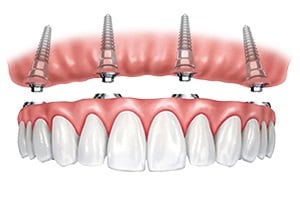
Much like the standard dental implant, these involve a screw that’s inserted into the jawbone to hold the new artificial tooth replacement with minimum of four (4) implants to support an entire arch of the teeth on each jaw.
In other words, each missing tooth won’t have its own implant. Instead, like the legs of a chair, four implants will be placed along the top and bottom jaws for an entire set of teeth, not individual tooth.
While a regular dental implant is designed to enhance, not replace, your smile, hybrid prosthesis are designed to replace the entire set of teeth when your teeth aren’t salvageable, or you don’t have any remaining.
How Does It Work?
A minimum of four titanium steel implants are perfectly spaced and inserted on each of the jaw bones. Fake teeth, akin to a crown in appearance, are then permanently attached to the rows of implants.
Advantages to Teeth in A Day
- Because single implants are charged per piece to fill an arch and all-on-four uses only four implants to fill all the arches, the cost of this procedure is much lower than other options.
- Another key advantage is that this procedure is surgically less complicated than traditional implants, requires fewer appointments, and requires less recovery time before normal eating can resume.
- Those with bone density loss may still be good candidates.
- Compared to regular dentures, teeth in a day feel and look more like your natural teeth.
- Temporary teeth are generally made in advance, meaning you don’t have to go without teeth while you wait for your permanent implant.
What’s the Cost of All-On-4 Dental Implantation?
Of course, cost will vary somewhat from dentist to dentist and insurer to insurer, but the real cost factor in hybrid prosthesis is in the materials used for the replacement teeth and the number of implants. Acrylic usually averages between $20,000 and $30,000. You can add around $5,000 per jaw for porcelain. Another key factor is the number of teeth per implant.
Who Is the Ideal Candidate for Teeth In A Day?
As with any implant procedure, Dr. Yepez will do some labs and X-rays to determine your overall general and oral health. The best candidates for teeth-in-a-day or hybrid prosthesis implants are those with extensive to complete tooth loss. It offers an affordable, minimally invasive, and permanent solution to those who aren’t candidates for other dental implants and/or don’t have the time to devote for other implant options.
How Do I Find an Implantation Dentist?
Always look to the ACP (American College of Prosthodontics) website for the best prosthodontist in your area. It’s also a good idea to ensure they have at least five years of experience directly with the type of procedure you’re considering.
If your regular dentist isn’t qualified to do your implants, you can always seek the expertise of Dr. Yepez at Pure Prosthodontics.


